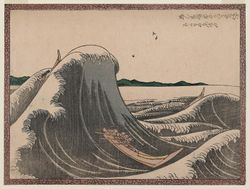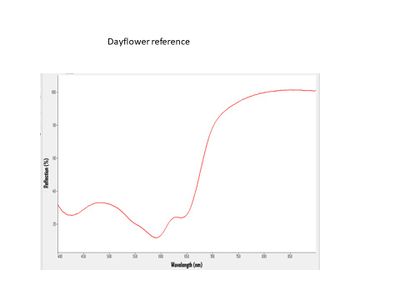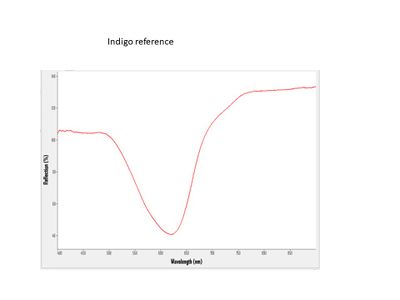Dayflower: Ukiyo-e colorant
Dayflower 青花(aobana): A blue dye extracted from the petals of Commelina communis var. hortensis (大帽子花 (ooboshibana)) better known as aobana. It is the cultivated from the Asiatic dayflower (Commelina communis) or tsukusa (露草) . The herbaceous annual plant gets its name because the blooms last for only one day.The blue colorant in the dayflower blue dye is primarily commelinin.
Indigo and dayflower are the two blues used in Japanese woodblock prints until Prussian blue enters the palette in the 1830's. Indigo appears most frequently from the 1740’s onwards as a color mixed with orpiment to produce a variety of greens. As a single colorant, it appears as a comparatively dull blue color. Due to its poor tinting strength, a relatively large amount needs to be used during printing in order to obtain a good saturation of this color. Its texture is somewhat coarse which makes it difficult to execute graduated hues from dark to light. Unlike dayflower, it is stable to moisture but is prone to fading.
For more information see: Dayflower
Examples of Dayflower in Ukiyo-e Prints

|

|

|

|

|
Analysis
Fiber optic reflectance spectroscopy (FORS) can easily identify the three blues: indigo, dayflower, and Prussian blue.
Other Images of Dayflower
List of Prints
List of prints where indigo was detected
Pages in category "Dayflower: Ukiyo-e colorant"
The following 52 pages are in this category, out of 52 total.
B
- Kiyonobu I, Actor Ôtani Hiroji I as the Candy-seller Kokusen-ya, 11.13165
- Bunchō, Actor Ichimura Uzaemon IX as Yoshiie, 34.333
- Bunchō, Actor Matsumoto Kôshirô III as Soga no Gorô, 11.18479
- Bunchō, Actor Segawa Kikunojô II, 06.1037
- Bunchō, Actors Nakamura Matsue I as Umegawa and Ichikawa Komazô II as Yoemon, 11.19316
E
H
- Harunobu, Beautiful Women of the Yoshiwara, Combing hair (2006.1537.1)
- Harunobu, Ebisu and Ofuji, from the series The Seven Gods of Good Fortune in the Modern World, 34.343
- Harunobu, Kojima Bingo no Saburô Takanori, 11.19633
- Harunobu, Nishikigi of the Kanaya Lighting Incense beside a Mosquito Net, 11.16479
- Harunobu, Parody of the Three Evening Poems: Teika, Jakuren, and Saigyô, 11.19703
- Harunobu, The Eleventh Month, from an untitled series of Twelve Months, 11.20120
- Harunobu, The Sake Cup, sheet 4 of the series Marriage in Brocade Prints, the Carriage of the Virtuous Woman, known as the Marriage series, 11.19475
- Harunobu, The Tenth Month, from an untitled series of Twelve Months, 11.20124
- Harunobu, Young Man Playing a Shakuhachi, 21.4677
- Harunobu, Young Woman Riding a Turtle (Parody of the Story of Urashima Tarô), 21.4594
- Harunobu, Young Woman Tuning a Shamisen, 06.479
- Hokusai, Woman, Child, and Man with Kite, from the series A Collection of Dances, 11.16764
K
- Kiyomasu II, Actor Segawa Kikunojô I in Momo Chidori Musume Dôjô-ji, 06.423
- Kiyomasu II, Actors Tamazawa Saijirô as the Courtesan Chidori and Ichimura Manzô as Takigô Tôshichi; Calendar for 1744, 21.5455
- Kiyomasu II, The Arrival of the Elephant, 58.343
- Kiyomitsu I, Actor Ichikawa Danzô III as Adachi Hachirô, 11.19030
- Kiyomitsu I, Actor Segawa Kikunojô II as Itsuki, 11.19020
- Kiyomitsu I, Actors Segawa Kikunojô II as the Courtesan Katsuragi and Ichimura Uzaemon IX as Nagoya Sanza, 45.832
- Kiyomitsu I, Actors Ôtani Hiroji III as Okabe no Rokuyata and Nakamura Sukegorô II as Inomata no Koheiroku, 46.1409
- Kiyomitsu I, Yoritomo's Hunt at the Foot of Mount Fuji, 11.19694
- Kiyonaga, The Brine Maidens, from the series Current Manners in Eastern Brocade, 11.13880
- Kiyonaga, The Brine Maidens, from the series Current Manners in Eastern Brocade, 21.5610
- Komatsuken, Courtesan Parading with Two Kamuro, 11.19711
- Koryusai, Descending Geese at Mimeguri, from the series Fashionable Eight Views of Edo, 11.14627
- Koryusai, Twilight Snow of the Bride, from the series Eight Views of Fashionable Human Relations, 11.19541
- Kunisada, Actor Nakamura Utaemon III as the Monkey Trainer Yojirô, from the series Great Hit Plays, 11.15095
- Kunisada, Actor Sawamura Tanosuke II, from the series Actor Rebuses, 11.42324
- Kunisada, Actors Iwai Kumesaburô II as Agemaki (R), Ichikawa Danjûrô VII as Sukeroku (C), and Onoe Kikugorô III as Shinbei (L), 21.7532-4
- Kunisada, Komurasaki of the Kado-Tamaya, kamuro Kochô and Sayuri, from the series Comparison of Beauties of the Pleasure Quarters, 11.20991
- Kunisada, Moon Viewing at Mukôjima, a Triptych, from the series Moon, Snow and Flowers, 11.15216
- Kuniyoshi, Ruan Xiaowu, the Short-lived Second Son, from the series One Hundred and Eight Heroes of the Popular Shuihuzhuan, 64.800
- Kuniyoshi, The Ninth Hour: Noon; Woman Playing with Cat, Fishmonger and Dog, from the series Sundial of Modern Tradesmen, 11.15955
S
- Shinsai, Chapters 16–18, from the series The Tale of Genji, 11.21066
- Shunkō, Actors Ichikawa Danjûrô V as Fukurokuju, Iwai Hanshirô IV as Ryûyô Dôji, and Sawamura Sôjûrô III as Shin'yô Dôji, 11.14971
- Shunkō, Actors Nakamura Nakazô I and Ôtani Hiroji III, 11.2014
- Shunshō, Actor Segawa Kikunojô III as Shirokiya Okoma, from the series Fans of the East, 11.14871
- Shunshō, No. 3, Comparative Poems, from the series Six Types of Waka Poetry as Described in the Preface of the Kokinshû, 11.19295
- Shunshō, No. 6, Cui Zongzhi (Saisôshi), from the series Eight Immortals of The Wine Cup, 11.14847







